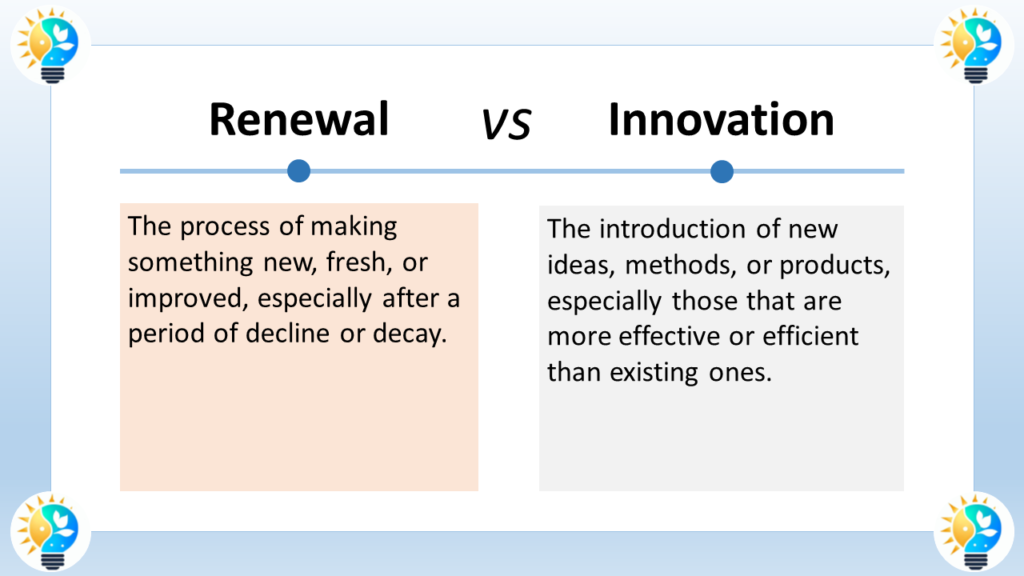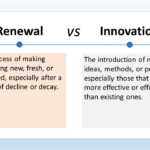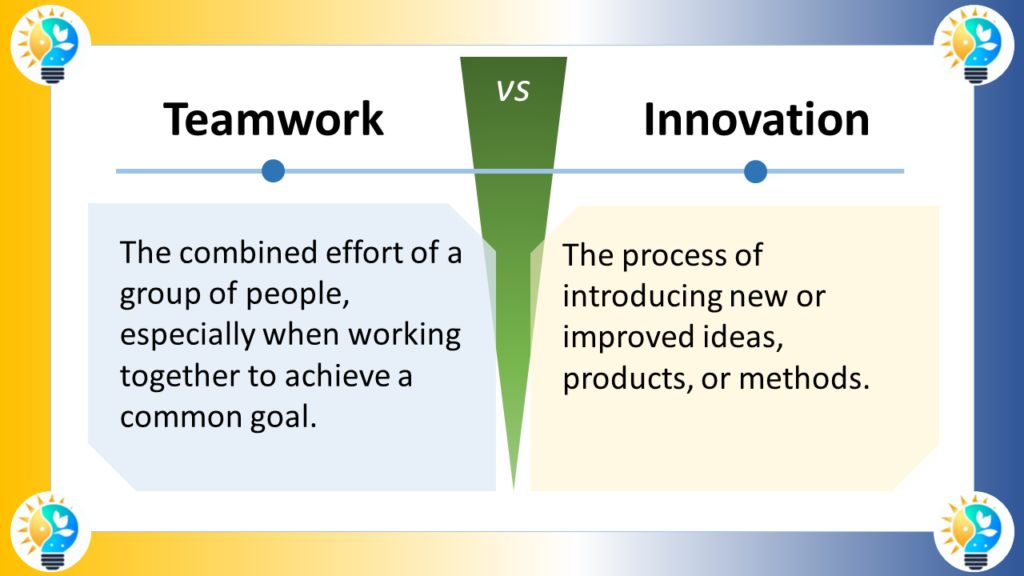
Renewal focuses on revitalizing or rejuvenating something that has deteriorated or become obsolete.
It often introduces innovative approaches or solutions to bring about improvement or transformation
Innovation frequently serves as a catalyst for renewing outdated systems or processes, ushering in revitalization and growth.
Definitions
Innovation
Innovation refers to the process of creating new ideas, products, services, or processes that add value and improve upon existing solutions. It involves thinking outside the box, challenging conventional wisdom, and embracing risk to drive meaningful change. Innovation is essential for organizations to remain relevant and maintain a competitive edge in their respective industries. It can take various forms, such as incremental innovation (improving existing products or processes), disruptive innovation (introducing entirely new products, services, or business models that disrupt the market), and radical innovation (revolutionizing an industry through groundbreaking technologies or concepts).
Renewal
Renewal is the ongoing process of revitalizing and updating existing systems, processes, and structures within an organization. This might involve refining current products, optimizing workflows, enhancing company culture, or reevaluating strategic goals. Renewal is critical for ensuring that an organization operates efficiently and effectively, allowing it to build upon its past successes and avoid stagnation. By continuously assessing and improving existing practices, organizations can stay agile and responsive to changing market conditions, ultimately contributing to their long-term growth and sustainability.
More Synonyms on innovation, innovate and innovative
Innovation Terms

Innovation is considered as a driving force in progress.
It includes the introduction of novel ideas, methods, or products that bring positive change and advancement.
For more information about innovations, check our glossary
Innovation: The Engine of Progress
Innovation can be defined as the process of creating new ideas, products, or services that add value and improve upon existing solutions. It involves thinking outside the box, challenging conventional wisdom, and embracing risk to drive meaningful change. Innovation is essential for organizations to remain relevant and maintain a competitive edge in their respective industries.
Renewal: The Catalyst for Continuous Improvement
Renewal, on the other hand, refers to the ongoing process of revitalizing and updating existing systems, processes, and structures within an organization. This might involve refining current products, optimizing workflows, or enhancing company culture. Renewal is critical for ensuring that an organization operates efficiently and effectively, allowing it to build upon its past successes and avoid stagnation.
Why Innovation and Renewal Go Hand-in-Hand
While innovation and renewal serve different purposes, they are deeply interconnected and rely on one another to foster sustainable growth and progress. Here are three reasons why this dynamic duo is essential for driving success:
- Balancing Creativity and Efficiency
Innovation and renewal work together to strike a balance between creativity and efficiency. Innovation encourages organizations to push boundaries and explore new possibilities, while renewal focuses on refining and improving existing practices. By combining these two approaches, organizations can maximize their potential for growth and development.
- Fostering a Culture of Continuous Learning
Both innovation and renewal require a commitment to continuous learning and adaptation. By encouraging employees to embrace new ideas and challenge the status quo, organizations create an environment that fosters growth and development. This culture of learning not only drives progress but also helps attract and retain top talent.
- Adapting to Changing Market Conditions
In today's fast-paced business landscape, organizations must be agile and responsive to changing market conditions. Innovation enables companies to anticipate and capitalize on emerging trends, while renewal ensures that they remain efficient and effective in the face of new challenges. Together, innovation and renewal enable organizations to stay ahead of the curve and thrive in an ever-evolving marketplace.
Case Study: Apple Inc. – A Master of Innovation and Renewal
Apple Inc. provides a prime example of how successful the combination of innovation and renewal can be. Over the years, Apple has consistently introduced groundbreaking products that have revolutionized various industries, from the iPod and iPhone to the iPad and Apple Watch. These innovations have solidified Apple's position as a market leader and kept the company at the forefront of technology.
At the same time, Apple has continuously renewed and refined its existing product lines, enhancing user experience and optimizing performance. This commitment to renewal is evident in the regular updates to the iOS operating system, as well as the ongoing improvements made to hardware components across its product portfolio.
By combining innovation and renewal, Apple has created a powerful engine for growth and sustained its competitive advantage in the highly competitive technology sector.
Conclusion: Harnessing the Power of Innovation and Renewal
In conclusion, the relationship between innovation and renewal is critical for driving progress and ensuring long-term success. By striking a balance between creativity and efficiency, fostering a culture of continuous learning, and adapting to changing market conditions, organizations can harness the power of this dynamic duo to stay ahead of the curve and thrive in today's rapidly evolving business landscape.
FAQ
Q: Can renewal lead to innovation?
A: While less common, renewal efforts that introduce significant changes or improvements could potentially result in innovative outcomes.
Q: Is innovation always better than renewal?
A: Not necessarily. The choice between renewal and innovation depends on specific needs, resources, and goals. Sometimes, renewal is more appropriate and effective.
Q: How do renewal and innovation contribute to progress?
A: Renewal ensures the continued relevance and functionality of existing systems, while innovation introduces new solutions that can lead to significant leaps in progress.
Q: Can a project involve both renewal and innovation?
A: Yes, a project can combine elements of renewal (updating existing aspects) with innovation (introducing new features or approaches).
Sources
- Tidd, J., & Bessant, J. (2018). Managing innovation: Integrating technological, market and organizational change. John Wiley & Sons.
- Senge, P. M. (2010). The fifth discipline: The art and practice of the learning organization. Random House Business.
- Christensen, C. M., & Raynor, M. E. (2003). The innovator's solution: Creating and sustaining successful growth. Harvard Business Press.
- Ismail, S., Malone, M., & van Geest, Y. (2014). Exponential organizations: Why new organizations are ten times better, faster, and cheaper than yours (and what to do about it). Diversion Books.
- Apple Inc. (2022). Apple Inc. annual report.


